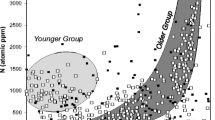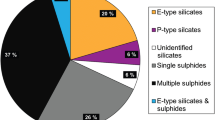Abstract
Diamonds from the Juina-5 and Collier-4 kimberlites and alluvials in the Juina area, Brazil (which are important occurrences of ultra-deep diamonds) were characterised and studied using cathodoluminescence, FTIR and SIMS. Resorbed forms are most frequent, followed in abundance by octahedral diamonds. Cathodoluminescence revealed a high abundance of non-luminescent stones with minor occurrence of diamonds with blue luminescence, which is consistent with the high abundance of Type II diamonds (> 69 %). Type I diamonds are IaB or highly aggregated IaAB and most lack platelets, implying degradation of such features due to high temperature annealing after growth. The δ13C distribution of Juina samples forms two groups: -26.3 to -3 % without any significant mode for Juina-5 and Collier-4 diamonds, and -13.8 to -3.4 % with -5 % mode for alluvial stones, suggesting that these two kimberlites are not the main source of the local alluvial diamonds. Intracrystalline δ13C and N SIMS measurements showed consistent co-variation in only one of five diamonds, providing possible evidence of carbon isotope fractionation. Resorption horizons and erratic C-N co variation for the other samples suggest episodic growth. The internal growth features and N characteristics of Type I diamonds indicate that some of them were probably formed in the lithospheric mantle, while most Type II diamonds are tentatively related to a sublithospheric “ultradeep” paragenesis, which is yet to be confirmed by mineral inclusions. Previous studies suggest that sublithospheric diamonds were transported from the deep mantle and deposited at the base of the lithosphere prior to exhumation by kimberlite, possibly by a mantle plume. The characteristic carbon isotopic compositions of Juina-5 and Collier-4 diamonds compared with alluvial diamonds suggest that distinct diamond populations exist in the kimberlite source region.
Access this chapter
Tax calculation will be finalised at checkout
Purchases are for personal use only
Similar content being viewed by others
References
Araujo DP, Gaspar JC, Bizzi LA (2001) Morphology and surface features of diamonds from the Juína Kimberlite province, Brazil. Rev Bras Geo 31(4):605–615
Araujo D (2002) Mineralogy of diamonds from the Juina Kimberlite Province, MT (in Portuguese). PhD thesis. University of Brasília. Brasília, p 195
Boyd SR, Kiflawi I, Woods GS (1995) Infrared absorption by the B nitrogen aggregate in diamond. Phil Mag B72(3):351–361
Boyd SR, Kiflawi I, Woods GS (1994) The relationship between infrared absorption and the a defect concentration in diamond. Phil Mag B69(6):1149–1153
Brenker FE, Vollmer C, Vincze L, Vekemans B, Szymanski A, Janssens K, Szaloki I, Nasdala L, Joswig W, Kaminsky FV (2007) Carbonates from the lower part of transition zone or even the lower mantle. Earth Planet Sci Lett 260(1–2):1–9
Bulanova GP, Walter MJ, Smith CB, Kohn SC, Armstrong LS, Blundy J, Gobbo L (2010) Mineral inclusions in sublithospheric diamonds from Collier 4 kimberlite pipe, Juina, Brazil: subducted protoliths, carbonated melts and primary kimberlite magmatism. Contrib Min Petrol 160(4):489–510
Davis GL (1977) The ages and uranium contents of zircons from kimberlites and related rocks, vol 76. Carnegie Institution of Washington Year Book, Washington, pp 631–635
Davies RM, Griffin WL, Pearson NJ, Andrew AS, Doyle BJ, O’Reilly SY (1999) Diamonds from the deep: pipe DO-27, Slave Craton, Canada. In: Gurney JJ, Gurney JL, Pascoe MD, Richardson SH (eds) Proceedings of 7th international Kimberlite conference, vol 1. Red Roof Design, Cape Town, pp 148–155
Deines P (1980) The carbon isotopic composition of diamonds: relationship to diamond shape, color, occurrence and vapor deposition. Geochim Cosmochim Acta 44:943–961
Deines P, Harris JW, Gurney JJ (1987) Carbon isotopic composition, N content and inclusion composition of diamonds from the Roberts Victor Kimberlite, South Africa: evidence for 13C depletion in the mantle. Geochim Cosmochim Acta 51:1227–1243
Deines P, Harris JW, Spear PM, Gurney JJ (1989) Nitrogen and δ13C content of Finsch and Premier diamonds and their implications. Geochim Cosmochim Acta 53:1367–1378
Deines P, Harris JW, Gurney JJ (1991) The carbon isotopic composition and nitrogen content of lithospheric and asthenospheric diamonds from the Jagersfontein and Koffiefontein kimberlite, South Africa. Geochim Cosmochim Acta 55:2615–2625
Hall AE, Smith CB (1985) Lamproite diamonds—are they different? In: Glover JE, Harris PG (eds) Kimberlite occurrence and origin, vol 8. University of Western Australia, Geology Department Publication, pp 167–212
Haralyi N (1991) Os diamantes de Juina, Mato Grosso. In: Principais depósitos minerais do Brasil, vol IV. (Parte A), pp 155–160
Harte B, Harris JW (1994) Lower mantle mineral associations preserved in diamonds. Min Mag A58:384–385
Hauri EH, Wang J, Pearson DG, Bulanova GP (2002) Microanalysis of δ13C, δ15N, and N abundances in diamonds by secondary ion mass spectrometry. Chem Geol 185(1–2):149–163
Hayman PC, Kopylova MG, Kaminsky FV (2005) Lower mantle diamonds from Rio Soriso (Juina area, Mato Grosso, Brazil). Contrib Min Petrol 149(4):430–445
Heaman LM, Teixeira NA, Gobbo L, Gaspar JCA (1998) U-Pb zircon ages for kimberlites from the Juina and Paranatinga provinces, Brazil. In: 7th international Kimberlite conference, long abstracts, Cape Town, pp 322–324
Hutchison M (1997) Constitution of the deep transition zone and lower mantle shown by diamonds and their inclusions, PhD Thesis. University of Edinburgh
Hutchison MT, Cartigny P, Harris JW (1999) Carbon and nitrogen composition and physical characteristics of transition zone and lower mantle diamonds from São Luiz, Brazil. In: Gurney JJ, Gurney JL, Pascoe MD, Richardson SH (eds) Proceedings of the 7th international Kimberlite conference, Cape Town, pp 372–382
Jaques AL, O’Neill HSC, Smith CB, Moon J, Chappell BW (1990) Diamondiferous peridotite xenoliths from the Argyle (AK1) lamproite pipe, Western Australia. Contrib Min Petrol 104:255–276
Kaminsky F, Zakharchenko O, Davies RM, Griffin W, Khachatryan G, Shiryaev A (2001) Superdeep diamonds form the Juina area, Mato Grosso State, Brazil. Contrib Min Petrol 140(6):734–753
Kaminsky F, Le Noan C (2009) A technical report on the Juina diamond project, Juina, Mato Grosso, Brazil. Technical report 43–101 F1, Diamond Exploration Inc., p 85
Kaminsky FV, Khachatryan GK, Andreazza P, Araujo D, Griffin WL (2009) Super-deep diamonds from kimberlites in the Juina area, Mato Grosso State, Brazil. Lithos 112(Supplement 2):833–842
Kaminsky FV, Sablukov SM, Belousova EA, Andreazza P, Tremblay M, Griffin WL (2010) Kimberlitic sources of super-deep diamonds in the Juina area, Mato Grosso State, Brazil. Lithos 114(1–2):16–29
Kiflawi I, Spear PM, van Wyk JA, Wood GS (1994) Infrared absorption by the single nitrogen and a defect centers in diamond. Phil Mag B69(6):1141–1147
Robinson DN (1980) Surface textures and other features of diamonds. PhD Thesis. University of Cape Town. Natal, South Africa, p 221
Silva GH, Leal J, Montalvão R, Bezerra P, Pimenta O, Tassinari C, Fernandes C (1980) In: RadamBrasil P (ed) Folha SC-21. Juruena. 1—Geologia, p 456
Stachel T, Harris JW, Aulbach S, Deines P (2002) Kankan diamonds (Guinea) III: δ13C and nitrogen characteristics of deep diamonds. Cont Min Petrol 142:465–475
Stachel T, Harris JW, Muehlenbachs K (2009) Sources of carbon in inclusion bearing diamonds. Lithos 112(Suppl. 2):625–637
Sunagawa I (1984) Morphology of natural and synthetic diamond crystals. In: Sunagawa I (ed) Materials science of the earth’s interior, pp 303–330
Tassinari CCG, Macambira MJB (1999) Geochronological provinces of the Amazonian craton. Episodes 22:174–182
Tassinari CCG, Betterncourt JS, Geraldes MC, Macambira MJB, Lafon JM (2000) The Amazonian craton. In: Cordani UG, Milani EJ, Thomaz Filho A, Campos DA (eds) Tectonic evolution of South America, pp 41–96
Teixeira NA, Gaspar JC, Waissel O, Almeida AJ, Belther JA., Gobbo L (1998) Geology in the Juina Diamondiferous province. Extended abstracts. In: Seventh international kimberlite conference, Cape Town, pp 905–907
Walter MJ, Bulanova GP, Armstrong LS, Keshav S, Blundy JD, Gudfinnsson G, Lord OT, Lennie AR, Clark SM, Smith CB, Gobbo L (2008) Primary carbonatite melt from deeply subducted oceanic crust. Nature 454(7204):622–625
Walter MJ, Kohn SC, Araujo D, Bulanova GP, Smith CB, Gaillou E, Wang J, Steele A, Shirey SB (2011) Deep mantle cycling of oceanic crust: evidence from diamonds and their mineral inclusions. Science 334(6052):54–57
Watt GR, Harris JW, Harte B, Boyd SR (1994) A high-chromium corundum (ruby) inclusion in diamond from the Sao Luiz alluvial mine. Brazil. Min Mag 58(3):490–492
Wilding MC, Harte B, Harris JW (1991) Evidence for a deep origin for Sao Luiz diamonds. In: 5th international kimberlite conference, Araxá, Brazil, pp 456–458
Wirth R, Vollmer C, Brenker FE, Matsyuk S, Kaminsky FV (2007) Inclusions of nanocrystalline hydrous aluminium silicate “Phase Egg” in superdeep diamonds from Juina (Mato Grosso State, Brazil). Earth Planet Sci Lett 259(3–4):384–399
Woods G (1986) Platelets and the infrared absorption of type Ia diamonds. Proc Royal Soc London. Series A. Math Phys Sci 407(1832):219–238
Woods GS, Collins AT (1983) Infrared absorption spectra of hydrogen complexes in type I diamonds. J Phys Chem Solids 44(5):471–475
Acknowledgments
The authors wish to thank Rio Tinto Brasil (RTDM) for providing samples for this study. We thank the analytical support of G. Szabó for CL images at University of São Paulo, Arnaldo Alcover Neto for assistance with SEM images, J. Rougvie for CL images and FTIR work at the Smithsonian Institution and Y. Fei and R. Hemley for the support during the work at Carnegie Institution. D. Fisher (DTC Research Centre) is thanked for providing the CAXBD97.XLS spreadsheet for FTIR data deconvolution. We are greatly thankful to P. Cartigny, W.L. Griffin, O. Navon and T. Stachel, and to the Guest Editor, J. Harris, for constructive reviews made during different periods of building this manuscript. We thank Sami Mikhail for the helpful input in diamond growth modelling discussion. This research was funded by CNPQ (National Counsel of Technological and Scientific Development), FINATEC (Fundação de Empreendimentos Científicos e Tecnológicos) and CAPES (Centro de Aperfeiçoamento de Ensino Superior).
Author information
Authors and Affiliations
Corresponding author
Editor information
Editors and Affiliations
Rights and permissions
Copyright information
© 2013 Geological Society of India
About this paper
Cite this paper
Araujo, D.P. et al. (2013). Juina Diamonds from Kimberlites and Alluvials: A Comparison of Morphology, Spectral Characteristics and Carbon Isotope Composition. In: Pearson, D., et al. Proceedings of 10th International Kimberlite Conference. Springer, New Delhi. https://doi.org/10.1007/978-81-322-1170-9_16
Download citation
DOI: https://doi.org/10.1007/978-81-322-1170-9_16
Published:
Publisher Name: Springer, New Delhi
Print ISBN: 978-81-322-1169-3
Online ISBN: 978-81-322-1170-9
eBook Packages: Earth and Environmental ScienceEarth and Environmental Science (R0)




